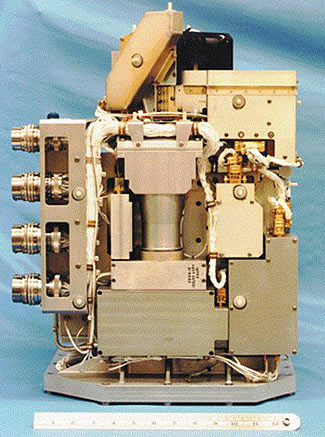STAR / SMCD / SPB Solar Backscatter Ultraviolet (SBUV/2) Project

SBUV/2 Instrument
Solar Backscatter Ultraviolet Radiometer, developed by Ball Aerospace, Boulder, CO. The SBUV/2 is a non-scanning, nadir viewing instrument designed to measure scene radiance in the spectral region in 12 channels between 255 nm and 340 nm. Measurement of ozone profiles and of backscatter radiation. Photo credits
Overall Goal
The overall goal of the SBUV/2 reprocessing team is to produce a long term data record for total column and profile ozone that is as accurate as possible. The team implements algorithm upgrades and calibration changes in an effort to measure the global total ozone column to an accuracy of 1% and the vertical distribution of ozone in the stratosphere to an accuracy of 5%. Incorporating innovative corrective solutions to problems such as stray light, out-of-band response, and wavelength shifts, allow for the reprocessed SBUV/2 data to approach these absolute accuracy values.
The SBUV/2 Instrument
The SBUV/2 is a nadir-pointing non-spatial, spectrally scanning, ultraviolet radiometer carried in two modules. The two modules are the Sensor Module, with optical elements/detectors, and the Electronics Module. The overall spectral resolution is approximately 1 nanometer (nm). Two optical radiometers form the heart of the instrument: a monochrometer and a Cloud Cover Radiometer (CCR). The monochrometer measures Earth radiance directly and the Sun selectively when a diffuser is deployed. The CCR measures the 379-nm wavelength and is co-aligned to the monochrometer. The output of the CCR represents the amount of cloud cover in a scene and is used to remove cloud effects in the monochrometer data.
The SBUV/2 measures solar irradiance and Earth radiance (backscattered solar energy) in the near ultraviolet spectrum. Wavelengths used for ozone calculations range from 252 nm to 340 nm. Built by Ball Aerospace, the SBUV/2 has been flown on several NOAA Polar Orbiting Environmental Satellites (POES) and has a continuous data record spanning over 24 years. Previously working SBUV/2 instruments were flown on NOAA-9, NOAA-11, and NOAA-14 satellites. Currently operating SBUV/2 instruments are being flown on NOAA-16, NOAA17, NOAA18, and NOAA19 satellites.
